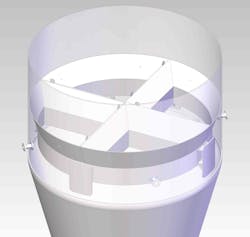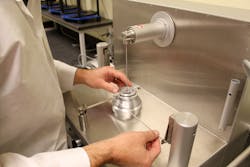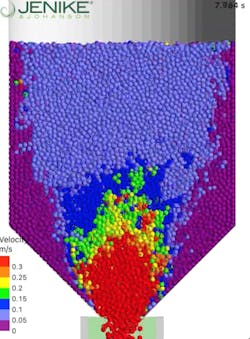Processing Q&A: Reflecting on 50 years in bulk solids with John Carson
Jenike & Johanson, Inc., (J&J) is the world’s largest and most experienced consulting engineering firm dedicated to the storage, flow and processing of powders and bulk solids. John W. Carson, PhD, began working for J&J in 1970 and served as the company’s president from 1985 until retiring from full-time employment in 2018. Carson is a founding member of the American Institute of Chemical Engineers (AIChE) Powder Technology Forum and belongs to ASME, ASCE and ASTM International, where he is a founder and former chair of subcommittee D18.24, “Characterization and Handling of Powders and Bulk Solids.”
During his career, Carson has written more than 150 articles dealing with solids flow, lectured extensively on bulk-solids-related topics and received many awards and honors. Processing recently caught up with Carson to discuss how the field of bulk solids handling has evolved over the course of his career and his advice for processors handling powders and bulk solid materials.
How did you get into the bulk solids handling industry and arrive at J&J?
I went to Northeastern University for my undergraduate education. My first co-op job was at a US Steel mill in eastern Pennsylvania, and my second was at their applied research center near Pittsburgh. I was fortunate to be assigned to their bulk solids research group, whose chief engineer was Jerry Johanson. Jerry left US Steel a year before I graduated and moved to the Boston area to join Andrew Jenike in forming J&J. I worked for them in the basement of Jenike’s home before starting graduate school at MIT. Upon completing my PhD, I joined the company full time, and 53 years later I’m still there!
What was the state of industry’s knowledge about bulk solids handling when you began your career? How was knowledge about bulk solids handling shared or disseminated within the industry?
It was pretty bleak. Most hoppers were either 45° or 60°, since all design engineers had 45° and 30-60-90° triangles in their desk. The most common material of construction was carbon steel since it was cheap and readily available. Pyramidal hoppers were more common than conical ones since they were easier to build. The outlet size was set by inlet dimensions of the feeder that was chosen based on flow rate, not arching or ratholing considerations.
Introducing a new technology to virtually every industry around the world was very difficult. We had to rely on writing technical papers and presenting them at conferences, then hoping that people with a solids flow problem would call on the phone.
What are some of the most important advancements or technological changes that occurred during your career in the field of bulk solids handling or processing?
There have been many. First and foremost is the use of computers. I started out drawing Mohr circles using a protractor, computing outlet dimensions using a slide rule, drawing sketches for my reports by hand, and handwriting my reports that were then typewritten by a secretary. Computers have allowed these steps to be performed much more quickly and accurately.
Second would be expansion of bulk solids technology to include two- and three-phase effects. When I started out, we only considered solid particles and ignored the effects of gas or liquid between particles. We can now calculate the effects of air counterflow on a solid’s discharge rate from a bin, how to determine the best way to add gases to a vessel to cause or prevent chemical reactions in the bulk solid flowing through it, and how best to use air to greatly increase the rate and uniformity of a bulk solid’s discharge.
Third would be the development of discrete element modeling (DEM), which has allowed engineers to study problems that were impossible to solve when I started out.
Finally, new test equipment has been developed that is useful in measuring different aspects of a bulk solid’s flow properties. This includes automated shear testers and specialized testers that can measure a bulk solid’s flow properties up to 2,200°F, abrasive wear properties, permeability, propensity to segregate, and attrition characteristics.
You mentioned the development of DEM software. What is your assessment of DEM’s utility currently, and how do you think the technology could impact bulk solids system design in the future?
DEM has come a long way since the turn of the century. Twenty years ago, the state-of-the-art was limited to spherical particles of varying size. Fifteen years ago, “gluing” spheres together to create clusters was introduced. Today, modeling of more realistic particle shapes using polyhedra is common.
While this technology holds huge potential, it is still a long way from modeling most “real” systems. For example, the number of particles in an industrial-size silo is on the order of 1015, but current DEM codes are only on the order of 106 particles for realistic run times — nine orders of magnitude difference! At present the demands on computing power are impractical, particularly considering that the time scale is inversely proportional to particle size. Then there is the very real problem of particle cohesiveness, which has yet to be fully addressed. Furthermore, as particles get smaller (real world or model), the effects of surrounding air or other gas become significant, so they must be included.
One must guard against assuming that pretty pictures and videos that “look right” are sufficient to ensure that the results of a DEM run are correct. For example, consider the two images shown in Figure 3. Both involve simulation of flow from a 45° conical hopper. The left figure was generated using spherical particles with low friction, while the one on the right was generated using polyhedral particles with more realistic friction. Anyone who has experience with hopper flow will quickly recognize that the simulation on the right is much closer to most real-world hopper flows than the one on the left.
It must be remembered that, at best, DEM can answer the question, “Why is this problem occurring?” It cannot provide guidance as to what to change to correct the problem. This is where the expertise of design engineers who have worked in this field for years comes into play.
You have written about the lack of bulk solids training in engineering programs despite bulk solids handling being one of the oldest and most prevalent industrial activities in the world. Why does this discrepancy persist? And what are the economic implications to companies of this lack of understanding of bulk solids behavior versus gas or liquid behavior?
Unlike fluid mechanics where the technology can be described by a series of equations and therefore taught rather easily, bulk solids technology is more complex. (My friend Lyn Bates of Ajax Equipment likes to say, “Bulk solids technology is not rocket science — it’s much more difficult than that! What’s more, rocket scientists agree!”)
Practical experience is needed in addition to a strong engineering background in continuum mechanics, mathematics and related fields to be able to teach this subject.
Finally, the lack of funding by government agencies such as NSF makes it difficult for academics to justify working in this field.
As for the economic impact of this lack of understanding and appreciation of bulk solids technology, consider the following:
In the early 1980s, the US Department of Energy commissioned the RAND Corporation to investigate the performance of 37 US- and Canadian-based processing plants with a view to understanding performance. Edward Merrow led a group that studied plants involved chemical transformations to some degree, and some featured new chemical routes; there were no new unit operations involved. The value chains studied also covered the full spectrum of feed, intermediate and product states (liquids, gases and solids).
The high-level findings from this very insightful study1 include:
- Value chains featuring bulk solids as the mainstream performed worse than plants featuring liquids or gases only.
- Two-thirds of these operations (featuring bulk solids) operated at less than 80% of their nameplate (design) capacity at the end of their first year, with a quarter failing to reach even 40%. The average for this cohort was 64% of nameplate compared to 90-95% for the liquid and gas operations.
- In terms of the root causes of these failures, lack of knowledge around heat and mass transfer was the biggest factor. While there are many heroes of fluid flow, the field of bulk solids flow, which is arguably as important and ubiquitous, is less well researched. Consequently, our understanding of the transport phenomenon associated with bulk solids is poor when compared to gases and liquids.
- Of the 37 plants studied, only 6% had no major performance issues (defined as a shut down for one or more weeks during the first year), and the overwhelming majority of problems involved related to process mechanics (bulk solids behavior) as opposed to chemistry.
- When compared to plants built in the 1960s (20 years prior) there was no difference (i.e., signs of improvement). The improvement effort during that period was found to be focused on process chemistry as opposed to mechanical processes (understanding flow and doing the bulk solids science homework).
Move forward another 20 years and in 2005 Bell2 raised the question,
Given the low plant productivity and long startup times associated with not taking Merrow’s advice, why would anyone build a new plant without fully piloting the design?
He noted that this question is at the center of many capital project decisions and figures prominently in the post-mortem of failed projects.
Bell’s work is a staggering finding that shows that the dial had not moved at all as a result of Merrow’s findings and recommendations. This finding was made even more poignant by the fact that it represented an even wider range of industries (food, nutraceutical, pharmaceutical, chemical, building materials, minerals processing, etc.). The common denominator in failure remained bulk solids. The common root cause of this was designers failing to do their homework and differentiate between the flow of liquids and bulk solids.
Here we are almost 20 years later, and the status remains essentially the same.
What advice would you give to companies experiencing ongoing or frequent challenges with bulk solids processes?
My first advice is don’t just live with the problem. There is no shortage of ways to improve one’s understanding of bulk solids processes, including attending short courses and technical conferences offered by engineering societies such as AIChE, reading technical publications that can be found using the internet, and contacting engineers at knowledgeable engineering and equipment supply firms. Expert help is available; all you have to do is ask.
When designing a new process line or plant, make sure that the following steps are followed:
- Characterize the actual bulk solids involved in the proposed process. Don’t fall for the easy path of “library values” that fail to capture the nuances that control the behavior of bulk solids.
- Make sure that operations personnel provide feedback to designers and that there is clear accountability for bulk solids flow and behavior issues in designs. The myth that any physical flow problems can be simply dealt with by the operation on startup needs to be killed.
- Give the behavior of bulk solids equal billing with chemistry in terms of research and development time. Debunk the myth that physical flow is trite and not worthy of attention.
- Don’t allow pride to brush aside possible problems. While Merrow's and Bell’s data represent averages — and most engineers consider themselves above average — don’t fall for the trap that you and your team are clever enough to beat the odds.
- Don’t let the legitimate need for innovation and haste to get new products or processes to the marketplace rush performing the necessary steps to successful design. The construction, operation, and refinement of a pilot plant will take many months and can cost millions of dollars. Business management may conclude — to their peril — that a business opportunity window will no longer be open if the process development timeline is too long.
What advice would you give to young engineers and operators working in industries that handle and process powders and bulk solids?
I am confident that the future is bright for individuals who are currently working in this field and for those who will join in the future. For those just starting out in this field, I offer the following advice:
- Find a mentor. Hopefully, you’ll learn from their experiences.
- Collaborate with others who have similar interests and drive — this is a team sport!
- Get “real world” (industrial) experience.
- Don’t be afraid to take chances, and don’t let mistakes and failures discourage or define you — learn from them instead.
- Continue to push boundaries of knowledge since there are many unsolved problems needing attention.
- Get involved with developers of silo codes.
- DEM is a great tool but use with caution.
- Work to make a difference in the world by, for example, helping to develop new foods that are more healthy and less expensive, finding new means for energy generation that are more efficient and less harmful to the environment, or reducing waste from industrial plants so there’s less harm to the environment.
References
- Merrow, E., “A quantitative assessment of R&D requirements for solids processing technologies”, Available at: https://www.rand.org/content/dam/rand/pubs/reports/2006/R3216.pdf, 1986.
- Bell, T. A., “Challenges in the scale-up of particulate process — An industrial perspective”, Powder Technology, 60-7, 2005.
Jenike & Johanson





